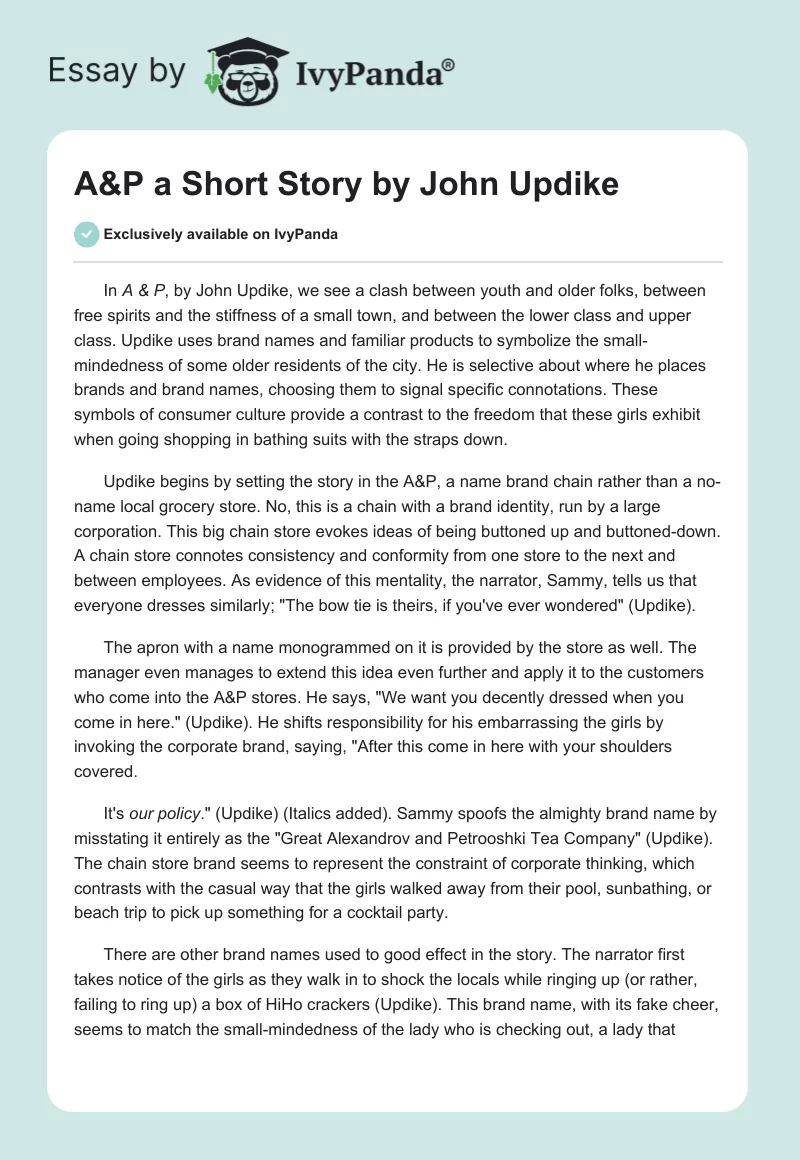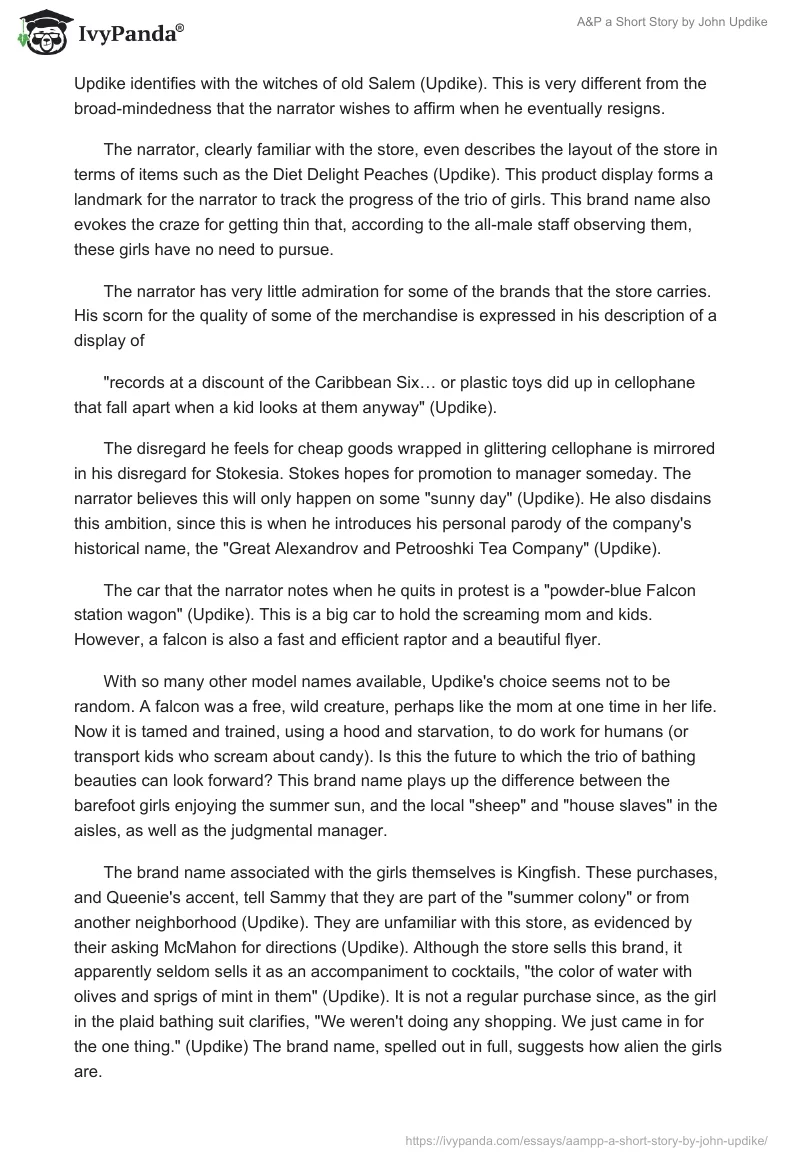In A & P, by John Updike, we see a clash between youth and older folks, between free spirits and the stiffness of a small town, and between the lower class and upper class. Updike uses brand names and familiar products to symbolize the small-mindedness of some older residents of the city. He is selective about where he places brands and brand names, choosing them to signal specific connotations. These symbols of consumer culture provide a contrast to the freedom that these girls exhibit when going shopping in bathing suits with the straps down.
Updike begins by setting the story in the A&P, a name brand chain rather than a no-name local grocery store. No, this is a chain with a brand identity, run by a large corporation. This big chain store evokes ideas of being buttoned up and buttoned-down. A chain store connotes consistency and conformity from one store to the next and between employees. As evidence of this mentality, the narrator, Sammy, tells us that everyone dresses similarly; “The bow tie is theirs, if you’ve ever wondered” (Updike).
The apron with a name monogrammed on it is provided by the store as well. The manager even manages to extend this idea even further and apply it to the customers who come into the A&P stores. He says, “We want you decently dressed when you come in here.” (Updike). He shifts responsibility for his embarrassing the girls by invoking the corporate brand, saying, “After this come in here with your shoulders covered.
It’s our policy.” (Updike) (Italics added). Sammy spoofs the almighty brand name by misstating it entirely as the “Great Alexandrov and Petrooshki Tea Company” (Updike). The chain store brand seems to represent the constraint of corporate thinking, which contrasts with the casual way that the girls walked away from their pool, sunbathing, or beach trip to pick up something for a cocktail party.
There are other brand names used to good effect in the story. The narrator first takes notice of the girls as they walk in to shock the locals while ringing up (or rather, failing to ring up) a box of HiHo crackers (Updike). This brand name, with its fake cheer, seems to match the small-mindedness of the lady who is checking out, a lady that Updike identifies with the witches of old Salem (Updike). This is very different from the broad-mindedness that the narrator wishes to affirm when he eventually resigns.
The narrator, clearly familiar with the store, even describes the layout of the store in terms of items such as the Diet Delight Peaches (Updike). This product display forms a landmark for the narrator to track the progress of the trio of girls. This brand name also evokes the craze for getting thin that, according to the all-male staff observing them, these girls have no need to pursue.
The narrator has very little admiration for some of the brands that the store carries. His scorn for the quality of some of the merchandise is expressed in his description of a display of
“records at a discount of the Caribbean Six… or plastic toys did up in cellophane that fall apart when a kid looks at them anyway” (Updike).
The disregard he feels for cheap goods wrapped in glittering cellophane is mirrored in his disregard for Stokesia. Stokes hopes for promotion to manager someday. The narrator believes this will only happen on some “sunny day” (Updike). He also disdains this ambition, since this is when he introduces his personal parody of the company’s historical name, the “Great Alexandrov and Petrooshki Tea Company” (Updike).
The car that the narrator notes when he quits in protest is a “powder-blue Falcon station wagon” (Updike). This is a big car to hold the screaming mom and kids. However, a falcon is also a fast and efficient raptor and a beautiful flyer.
With so many other model names available, Updike’s choice seems not to be random. A falcon was a free, wild creature, perhaps like the mom at one time in her life. Now it is tamed and trained, using a hood and starvation, to do work for humans (or transport kids who scream about candy). Is this the future to which the trio of bathing beauties can look forward? This brand name plays up the difference between the barefoot girls enjoying the summer sun, and the local “sheep” and “house slaves” in the aisles, as well as the judgmental manager.
The brand name associated with the girls themselves is Kingfish. These purchases, and Queenie’s accent, tell Sammy that they are part of the “summer colony” or from another neighborhood (Updike). They are unfamiliar with this store, as evidenced by their asking McMahon for directions (Updike). Although the store sells this brand, it apparently seldom sells it as an accompaniment to cocktails, “the color of water with olives and sprigs of mint in them” (Updike). It is not a regular purchase since, as the girl in the plaid bathing suit clarifies, “We weren’t doing any shopping. We just came in for the one thing.” (Updike) The brand name, spelled out in full, suggests how alien the girls are.
However, Updike does not use brand names everywhere as possible. Bread and pineapple juice remain unidentified, as do the aisle items that Sammy recites by heart, almost as a patter song (Updike). He chooses carefully to evoke the gulf between the girls, with their sense of privilege, and the townspeople who want to uphold a different standard of behavior.
Throughout, brand names symbolize class and attitude of mind, differentiating the summer folk girls from the year-rounders locals, youth from age, and small-mindedness from a more tolerant vision of the world.
Works Cited
Updike, John. “A & P.” Unknown. Print.


